
When contemplating a journey to Japan, the sheer excitement of the impending adventure often begins with selecting the most suitable airport to land in. A multitude of factors—including geographical location, flight availability, and the allure of surrounding attractions—can significantly influence your decision. This article delineates the principal airports in Japan that serve as entry points for international travelers, offering insights into their distinctive features and surrounding opportunities.
Japan’s unique archipelago structure means that each airport can immerse travelers in an entirely different regional experience. The nation, steeped in rich history and vibrant culture, beckons tourists from all corners of the globe. Thus, understanding which airport to choose can enhance not only convenience but also enrich your overall experience in this fascinating country.
Tokyo’s Narita International Airport (NRT)
Located approximately 60 kilometers east of downtown Tokyo, Narita International Airport is one of Japan’s busiest and best-connected airports. Notably, it serves as an extensive hub for international flights, particularly from North America and Europe. The airport is equipped with modern facilities and efficient transport connections to Tokyo. The JR Narita Express offers swift access to the city, ensuring travelers can commence their exploration with minimal delay.
The allure of Narita lies not only in its accessibility but also in the attraction of its vicinity. The town of Narita is home to the revered Naritasan Shinshoji Temple, an impressive Buddhist temple surrounded by lush gardens. Thus, travelers can begin their Japanese experience with a taste of its spiritual heritage while still at the airport’s doorstep.
Tokyo International Airport (Haneda) (HND)
Alternatively, for those who prioritize convenience, Haneda Airport is a prime choice. Situated merely 14 kilometers south of downtown Tokyo, Haneda is the closest major airport to the city center. Unlike Narita, it manages a considerable volume of domestic flights, allowing international travelers to connect easily to other regions of Japan. Consequently, a significant portion of travelers opts for Haneda as their international entry point.
The charm of Haneda extends beyond its proximity; it is renowned for its exemplary services and facilities, including shopping, dining, and cultural exhibitions. Visitors can indulge in an array of culinary experiences, ranging from sushi to traditional sweets, all within the airport premises. Such convenience significantly enhances the overall travel experience, making Haneda a compelling entry point for those eager to dive into Japan’s culinary delights.
Kansai International Airport (KIX)
For travelers headed to the culturally rich regions of Kansai, which encompass cities like Osaka, Kyoto, and Nara, Kansai International Airport stands as an excellent entry point. Nestled on a man-made island in Osaka Bay, KIX is approximately 50 kilometers from Osaka city center, and slightly farther from Kyoto. Although it is geographically distant from Tokyo, the airport provides an essential gateway to the southern regions of Japan.
Kansai International Airport is particularly noted for its innovative architecture and panoramic views of the sea and surrounding landscapes. It specializes in international flights, particularly from Asia and Oceania. Travelers arriving at KIX can take advantage of efficient rail services that link directly to Osaka and Kyoto. This seamless integration of ground and air transport allows for an enjoyable transition from air travel to regional exploration.
The proximity of Kansai to cultural landmarks such as the historic temples of Kyoto and the bustling streets of Osaka offers a unique opportunity for travelers to immerse themselves in Japan’s traditional and contemporary spheres almost immediately upon arrival. Such a blend enriches the traveler’s journey, providing a diverse perspective from the very beginning.
Chubu Centrair International Airport (NGO)
Situated approximately 35 kilometers south of Nagoya, Chubu Centrair International Airport is another noteworthy option for international travelers. While it may not be as bustling as Narita or Haneda, its strategic position serves as a vital hub for those seeking to explore Central Japan. The airport provides a balance of domestic and international flights, catering to various travel itineraries.
An often-overlooked feature of Chubu Centrair is the nearby attractions, including the historic Inuyama Castle and the World Heritage Site of Shirakawa-go, famous for its traditional gassho-zukuri farmhouses. The airport is renowned for its unique layout, featuring a terminal situated on a man-made island, which brings forth breathtaking waterfront views. This initial glimpse of Japan’s natural beauty sets the tone for an enchanting journey.
Fukuoka Airport (FUK)
For those planning to venture to the southern reaches of the archipelago, Fukuoka Airport is an indispensable option. As one of Japan’s most convenient airports, Fukuoka is located a mere 5 kilometers from the city center, allowing for a quick transition into the vibrant culture of Kyushu. While it may not handle as many international flights as other major airports, it serves as an important regional gateway, particularly for intra-Asian travel.
The city’s charm is undeniable, offering a vibrant food scene, historical sites, and unique attractions such as the Fukuoka Castle ruins and the Ohori Park. Fukuoka is particularly celebrated for its yatai (street food stalls), providing a delightful taste of local culinary culture just moments after descending from the plane.
Conclusion
Choosing the right airport for your arrival in Japan can significantly enhance your experience, aligning with your travel objectives and interests. From the bustling cosmopolitan life of Tokyo to the serene landscapes of Kansai, each airport offers a unique entry point into this mesmerizing country. Understanding the distinctive allure and facilities of each airport allows travelers to curate an experience that is not only convenient but also rich in cultural engagement. Whichever airport you choose, you will undoubtedly find Japan’s blend of tradition and modernity beckoning you to explore further.
